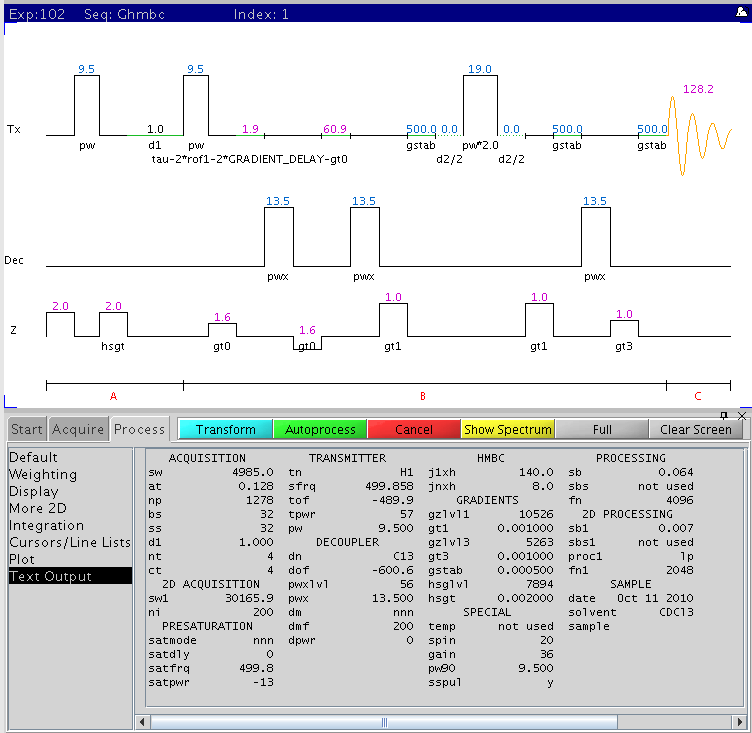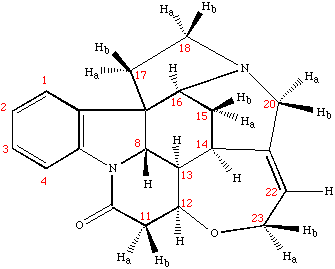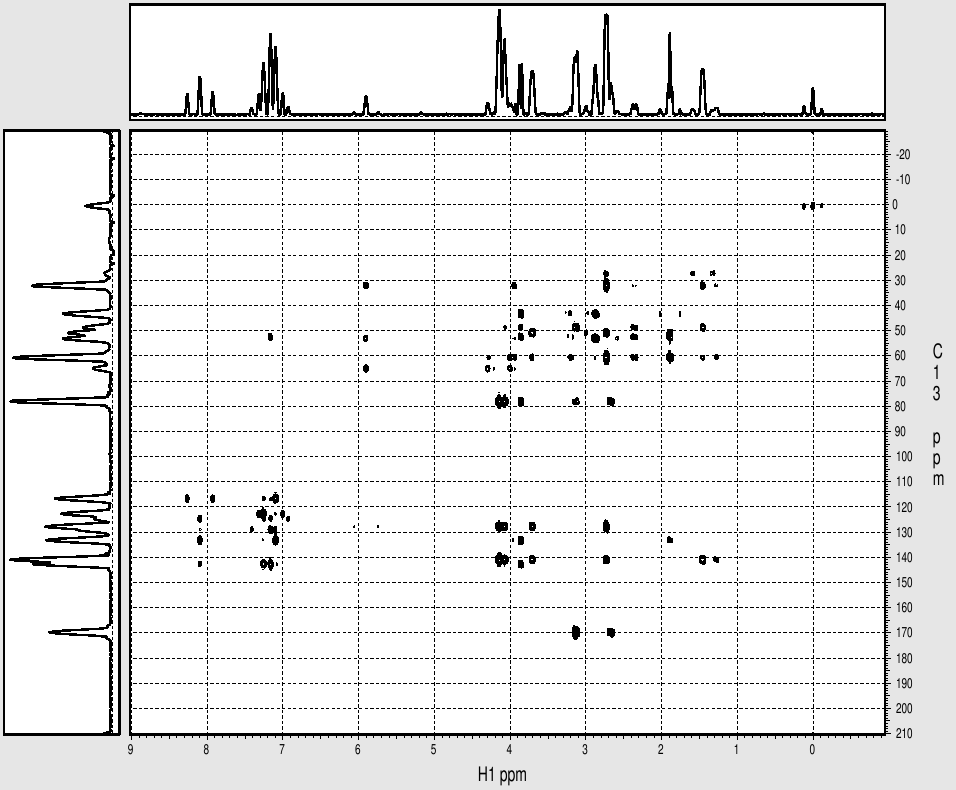Gradient
Enhanced HMBC
HMBC
(heteronucler multiple bond correlation) experiment reveals J couplings
(through-bond) across multiple bonds between 1H and 13C nuclei. The following
is the recommended gradient enhanced HMBC pulse sequence. No 13C decoupling is
applied during acquisition. As a result, the fine splitting along 1H reflects
the 1H<->13C J couplings in addition to homonuclear 1H<->1H couplings.

Procedure
- Temperature must be regulated.
- Spin must be OFF.
- Gradients amplifier should be turned on (displays RUN).
Type pfgon='nny' su to allow gradient pulses.
- Lock and shim your sample as usual, except also adjust X and Y shims a
bit (because spin is off now). Keep lock at ~80% after
shimming.
- Find proper sw and tof to use for 1H
channel
- Under exp1 (type jexp1 to go
there) collect a standard 1H spectrum with nt=1
- Put the box cursor to enclose the signal region
and to include ~10% flat baseline area at each end of the peak region. Type
movesw. This command sets a new spectral width
sw and spectrum center tof.
- Run another 1H spectrum with
nt=1 with the new setting. Reference the spectrum
carefully.
- Decide what 13C dof (center of spectrum) to use for 13C
channel.
- In the following we assume we want the 13C
center to be at 90ppm with a spectral width of 240ppm to give a 13C range
of -30 to 210ppm.
- Under exp1, following last step with 1H spectrum
referenced, type dn='C13'
- Type setrefppm and enter the
center ppm value you want for 13C. For 90ppm, enter 90.
- Write down the dof value
printed out above the command line. This is the offset value for 90ppm for
13C.
- Type jexp2 to goto exp2. If exp2 doesn't exist, type
cexp(2) jexp2.
- Load standard gHMBC experiment
- Type mf(1,2) to move fid from
exp1 to exp2 (current). Type wft f full.
- Type setexp('ghmbc') to load
gHMBC parameters. The script also sets 1H center and width to values in the
1D spectrum.
- Type su. Tune 1H channel and X nucleus channel. Accuracy
of pre-calibrated pw depends on probe tuning.
- Recable the X nucleus probe input cable.
- Disconnect the X nucleus cable at the filters in
front of the broadband preamp (left side). Connect the X-channel probe
input cable to one end of the long, 13C bandpass filter (labeled 13C on
filter) on the floor. Connect the other end of the filter to the X-channel
decoupler cable coming from the back of the magnet leg interface (long,
tall box to the right of the magnet).
- Re-shim Z1 and Z2 a bit after this cabling
change.
- Check/set proper 1H transmitter power and pulse width. If solvent is
CDCL3, tpwr=57 pw=9.5. These are the defualt values. For
other solvents, calibrate pw under another experiment
number according to this
procedure.
- Use default parameters values (~17 mins experiment) except the
following:
- Change solvent to yours
- pw=XXX pw90=pw
(9.5 for cdcl3 as solvent or value calibrated with your solvent at
tpwr=57)
- dof=XXX (value found above)
- sw1=XXX*dfrq (estimate it based
on how much you need to enclose all 13C peaks around dof).
XXX is the spectral width in ppm.
- Optionally, for better quality data (may results
in longer data collection time):
- ss=32 (more dummy scans before
data collection)
- nt=8 (or 16, 24, ... 4*n) for
more sensitivity and less artifacts
- ni=300 (better resolution along
indirect dimension. Default is 200)
- d1=2 (for less artifacts and
sensitivity, but doubles data collection time)
- Type time to check experiment time.
- Type go to collect data.
- Watch for ADC or receiver overflow: In arrayed
experiments such as 2D's, a fixed gain (not autogain) must be set. Watch
the receiver overflow light and the ADC overflow error message immediately
after the experiment starts. If the receiver overflows (red light blinks on
VT display) or ADC overflow message is seen above the command area anytime
during the experiment except during the dummy scan period, it is likely the
data are ruined. Stop the experiment and reduce gain by 2-4 at a time until
the overflow disappears. The default (gain=40) works most
of the time unless there is an extremely strong 1H signal in your sample.
With a gain above 20, it makes only small differences.
- After the experiment is done, recable the X (decoupler) channel
connection to the original configuration.
Example
Sample: Strychnine at ~ 25mg/mL (~ 100mM) in cdcl3
- Data collected October 2010 (~17 mins with nt=4
ni=200)
- Qurdrature detection: absolute-value mode
- 13C centered at 90ppm with a 240ppm spectral width.
- Processed and displayed with nmrPipe/nmrDraw
|
Strychnine

|
gHMBC spectrum of Strychnine

H. Zhou
Updated Oct 2010


